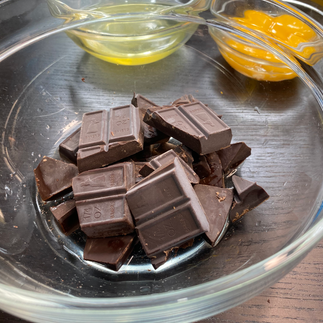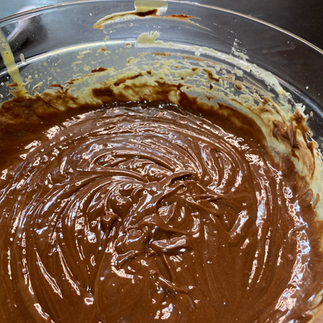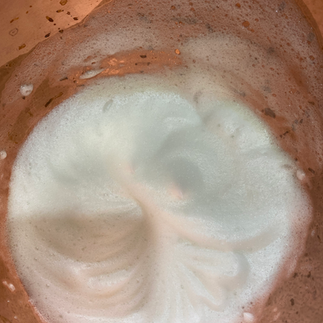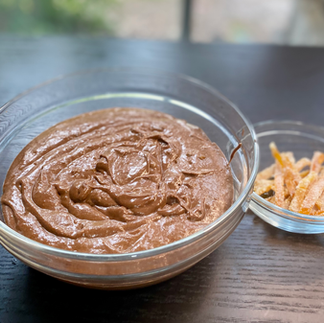Uncovering the Magic: Julia Child's Original Chocolate Mousse Recipe
Updated: Jan 26
Let's revisit the true, original recipe for Chocolate Mousse prepared by Julia Child in seasons 1 and 8 of The French Chef. Julia emphasized good technique rather than costly ingredients: this is our creed at InflationBites.com.

Julia Child prepared her Chocolate Mouse recipe twice on The French Chef, her groundbreaking television show on WGBH in Boston. In Season 1, Child made a version similar to the recipe in her landmark book, Mastering the Art of French Cooking. In Season 8, she made the recipe again, modified with easier techniques and a bit more foolproof. Like good cooks everywhere, she improved and simplified the recipe.
Julia Child was not a snob: she emphasized cooking techniques over expensive ingredients. On Season 1 of The French Chef, Julia made this recipe with chocolate chips. In Season 8, she admitted to using instant coffee. Despite this, some recipe sites will prepare Julia's chocolate mouse and admonish the home cook to buy only the finest chocolate or use only a particular liqueur. Stop it, already. Julia emphasized using good techniques to elevate common ingredients. Pay attention to whether your egg yolk mixture forms a "ribbon" or whether your chocolate is melted gently and is creamy. That is what makes a really great chocolate mouse. The other essential is adding more flavor through coffee, orange liquor, or candied orange peels. (I will advocate for candied orange peel, so be warned.)
Ingredients
First, let's take a look at the ingredients you'll need. One proviso to our readers: InflationBites.com is dedicated to fine cooking for less. We emphasize eliminating hard-to-find ingredients in favor of good basics and techniques. The secret to a quality dish is not spending money but paying attention to the details and learning good cooking techniques. So, let's look at what you need to make a great chocolate mousse. As Julia said, there are only four basic ingredients: eggs, sugar, chocolate, and butter. The rest are little additions for flavor.

Instant Sugar
Julia uses the phrase "instant sugar" to describe the superfine (caster's) sugar she used in season 1 and her cookbook. She stresses the importance of using instant

sugar because using granulated sugar might lead to an unpleasant granular sensation. This is because the cooked egg yolk mixture does not always get hot enough to melt granulated sugar (regular white sugar). By season 8, Julia abandoned instant sugar (perhaps highlighting the trend away from specialty baking sugars in US supermarkets). In that episode, Julia advocated putting the standard white sugar in the hot coffee and heating it just short of boiling. By doing this, the sugar is melted, thus avoiding any issues with texture. I present this version of the recipe in this post. Superfine sugar is expensive and hard to find: it is not sold at Walmart or Aldi, and I couldn't find it at Sprouts. I found it in my local Publix, but a small package costs much more than standard white sugar. This type of expensive, hard-to-find ingredient is what we avoid here on Inflation Bites. So, we will stick with Julia's solution to the superfine sugar problem: dissolve the standard white sugar in hot coffee.
Coffee
Since we are talking about hot coffee, this recipe calls for 1/4 cup of strong coffee.

Again, use what you have on hand. I like brewing a stronger coffee and grind in my little French press. But if you have an espresso machine, by all means use that. If you don't brew coffee at home, there are some really good instant espressos out there at minimal cost. You can buy a large bottle of cold brew at Aldi and keep it in the refrigerator. The taste is superior (I used this on the day I took these pictures). Remember to use the type of coffee you like the best. Heat the coffee in a saucepot, and add 3/4 cup of sugar. Put the hot mixture in a liquid measuring cup or frothing pitcher to make pouring it slowly into the egg yolks easier.
Liqueur
In the original recipe, Julia called for the use of orange liquor. The first time I made this recipe, 30 years ago, I invested in a bottle of Grand Marnier. Grand Marnier is a blend of cognac and triple sec. It was far too expensive at the time on a student's budget. Each time I make this recipe, I look at my supply of liqueur, and I often make it differently based on my mood. Sometimes, I want a very strong liquor flavor, and I might go for rum, while at other times, I want a more delicate flavor with orange liqueur. You have many options for a good chocolate mousse, but the best option is the one you like the best.
Triple Sec
My favorite liqueur in Chocolate Mouse is Triple Sec. The alcohol content in different triple secs varies greatly, from 15% to 40%. My favorite tripe sec is

Bols, which is 38% and a good budget option. De Kuyper is also good and quite inexpensive. Inexpensive triple secs are often 15% alcohol, but that is not problematic for chocolate mousse. I have noticed that many modern adaptations of Julia's chocolate mousse recipe cut the booze down to 2 tablespoons, or in half, perhaps showing a more recent preference for a more subtle liquor flavor. Inexpensive triple secs suit this because they pack a wallop of flavor without the strong flavor of the liqueur. For many people, that is a welcome alternative. While "boozy chocolate" is the current trend, Julia Child did not include liquor because she wanted the person tasting it to be aware of the alcohol. She used alcohol to enhance the flavor of the dish.
Rum or Whiskey
But here is the thing: Julia noted on The French Chef that any liquor or liqueur you liked could enhance this dish for you. She suggested rum or even whisky for those who wanted a stronger liquor flavor. I have tried rum, but I don't think it as much as triple sec or other liqueur. But everyone should determine this for themselves. Sometimes, I want the strong flavor of liquor and I go for rum in my mousse.
Other Liqueurs
Julia suggested that the flavor of orange liqueur complemented chocolate, but remember that other flavors also go extremely well with chocolate. Raspberry liqueur is wonderful in chocolate mousse and is also a favorite in this dish. Mint is another flavor that is insanely good with chocolate. Almond or nut-flavored liqueurs complement chocolate nicely. Chocolate or coffee-flavored liqueur intensifies the flavor of chocolate mousse. In short, use the liqueur you like the best. If you love it with chocolate, it will probably work well in this dish. Experiment with the flavor you love best!
Non-Alcoholic Choices
If you prefer not to use any alcoholic flavoring in your chocolate mousse, Julia recommended using vanilla or orange juice. If you make candied orange peels, the syrup left over from that process makes a great flavoring for chocolate mousse. Those flavored syrups you use to make your coffee drinks? They also make great flavoring for chocolate mousse.
Chocolate
Cooks posting this recipe online obsess about the type of chocolate to use. I'm not sure Julia would approve. In Season 1 of The French Chef, Julia made this recipe with chocolate chips. It was the mid-60s, and fake chocolate chips had not yet flooded the market, so they were a better choice. But still, Julia did not opt for fancy chocolate from Europe and throw shade on anyone who decided to use chocolate from the supermarket. Eight years later, when she made chocolate mousse again on The French Chef, Julia used baking chocolate squares but said she preferred to use Belgian or other Dutch chocolate. I suspect that these options were more available by that time. We should take a lesson from Julia here: she used what was available to her followers. When you make your chocolate mousse, use what you like that is affordable to you.

On the day I took these pictures, I chose to use plain old baking chocolate: it is inexpensive and readily available. Walmart normally sells four oz. of this chocolate for around $3, but I found them on sale for $2.25 and stocked up. You can buy Baker's chocolate for this recipe for around $4 if you live near a Walmart. If you choose to use chocolate chips, it's even cheaper, although I warn you that the result is not quite as good as baking chocolate.
There are some other great options out there. Trader Joe's is particularly strong in selling good-quality chocolate. Choose a semi-sweet or bittersweet variety. Target sells Ghirardelli 60% Cacao bars for around $3-4. Avoid "fake chocolate" or "chocolate flavored" baking chips as you choose your chocolate. The result using these is below par. But apart from that, choose a chocolate you like. More expensive doesn't necessarily mean better quality: I get the best results using Trader Joe's chocolate for all my baking projects.
Egg
This recipe uses four whole eggs. You can use any large whole egg you prefer

that is within your budget. Don't use extra-large or medium eggs, which will throw off the dish's balance.
Remember, however, that this recipe calls for raw egg whites. (The yolks are cooked briefly, and as long as they reach a temperature of 160 degrees, they should be safe.) Many recipes use raw whipped egg whites, and the incidence of any food poisoning from egg whites is rare. But remember to use fresh eggs that you have handled appropriately. This is not a recipe to make with a month-old carton of questionable eggs you left out overnight on one occasion. Choose a carton of fresh eggs and handle them safely.
If you are immuno-compromised, you may wish to use pasteurized eggs. This writer is a cancer survivor, and I know what it is to have to be careful at times. If you use pasteurized eggs, you will have difficulty whipping the egg whites. There are many videos out there showing how to whip pasteurized egg whites if they are whippable. (Check the carton before you buy.) Even if the whites can be whipped, it takes a long time and won't be as light. That's okay. The result will still be good. (And I said a prayer while typing that anyone reading this who is immunocompromised will be blessed with good health and a good appetite. )
Orange Peels
I saved the best for last. Julia's original recipe calls for finely chopped candied orange peels. I made this recipe many years ago when I purchased candied orange peels--the kind my mom put in fruitcake. The result was not very good. I

decided the "optional" orange peels in the recipe were a "no" in my kitchen. Recently, however, I have rethought this, and I hope you will do the same at some point. If you use orange liqueur in your mousse, it isn't complete without the orange peel. It elevates this dish and does not destroy the texture if you finely chop them.
I made the candied orange peel recipe posted by The Pioneer Woman and the result was a good peel.

This is now a favorite recipe, although I remove about half the pith before processing them. The recipe is simple: orange peels, sugar and water. That's right, you make candied orange peel from something you would otherwise throw in the garbage or compost. Don't let that throw you off: they are just delicious. I roll some in sanding sugar and some without. I dip some halfway in chocolate. They make a lovely garnish for desserts. If you love an Old-Fashioned cocktail, a piece of candied orange peel is just perfect in the glass.
If you ever decide to make candied orange peel, chop it finely and put it in your chocolate mousse. Candied orange peel keeps extremely well, so make a bunch and keep it in your refrigerator or freezer for later use.
Techniques for Julia's Original Mousse
Heating the Egg Yolks
Julia's recipe called for beating the egg yolks over simmering or hot water until they thicken. This process is central to producing a good result and make the yolks safer to eat. While you can beat your egg yolks at length, here is a secret: the magic starts to happen when your yolks reach 115-130 degrees. They really don't start to

thicken before this--get them creamy and light yellow so they are ready when the mixture reaches 115, but if you are getting frustrated that your mousse isn't thickening, it is probably because it simply isn't warm enough yet.
Having said this, it is also important that you don't overheat your egg yolks. You should be able to put your finger (that "impeccably clean finger" only, please) in the hot mixture without feeling discomfort.

Julia emphasized beating the yolks over the hot water by hand with a wire whisk, although you can certainly use a hand or stand mixture later after you take the yolk mixture off the hot water bath.
Big picture: don't rush this step as it is the most important step to get your texture right.
Dissolving the Sugar in Coffee

In Season 8, Julia changed the recipe in Mastering the Art of French Cooking to include dissolving the sugar in the hot coffee and adding this hot mixture to egg yolks that had been whipped over hot water. (The cookbook version called for beating the sugar into the egg yolks before heating.) I like this change a lot. Use care not to "cook" your egg yolks by adding the hot coffee too quickly, and do not cook the sugar and coffee into syrup (just heat it). This gives the yolks a head start on warming up and eliminates the need for superfine or instant sugar.
Keep Beating Those Egg Yolks
Continue beating the yolks and coffee mixture until it thickens. When this happens, remove the mixture from the water bath. Now, continue beating the mixture with a hand mixer until ribbons form (you can also do this in a stand mixer). The magic happens when eggs, sugar, and a little coffee are transformed into the mousse. Don't rush this step. When done, your mousse will "form ribbons." This means that when you pour the mousse off a spoon, it holds its shape briefly or "forms ribbons." This is extremely hard to capture while holding a camera in one hand and a spoon in the other, but look at the middle picture below. The mixture briefly holds its shape when drizzled off a spoon. Is it time to stop beating? Hardly, friend. Now it's time to beat the butter in, one tablespoon at a time.
As you finish this task, the mixture should have cooled to room temperature. It's ready for the chocolate.
Melt the Chocolate over Hot Water with Liqueur
Place whatever liqueur you use in a glass or metal bowl over
hot water. Break the chocolate into pieces, put it into the bowl, and cover it. Let the heat and time work: the chocolate will be melted in a few minutes. Whip it lightly with a whisk. If the chocolate isn't melting, heat your water a little.
Add the Chocolate to the Egg Yolk Mixture
Drizzle the chocolate into the egg yolk mixture. It should have cooled nicely. Gently incorporate the chocolate into the egg yolk mixture. Do not beat it at this point. From here on, treat the mixture gently so as not to "deflate" it or make it runny.
Whip the Egg Whites
In a stand or hand mixture, beat the egg whites. Notice the old copper liner to my Kitchen Aide mixer. This mixer and the liner are more than 30 years old. If you

can nab an old Kitchen Aide and its valuable accessories from a family member who is downsizing or an estate or garage sale, do it. These mixers last forever. It seemed like a big expense then, but this mixer has made birthday cakes, care package cookies, and dinner party delights for those I love. Every birthday cake I have made my daughter has been made in this old Kitchen Aide. If you are getting married soon, put a Kitchen Aide on your registry. If not, put a Kitchen Aide on your Amazon wish list. Or save up for one. You will never be disappointed, even if the cake falls or the dinner party is dull. But whatever type of mixer you have (or even if you beat them by hand with a whisk), you should beat the egg whites until they form stiff peaks. Don't beat them until they are dry, but make sure they are not runny.
It All Comes Together
Make sure your egg whites are stiff. Then, get a rubber spatula and fold the egg whites into the mousse. Fold it gently and incorporate it fully. Your mousse is complete. It needs another hour or so in the refrigerator to cool and set fully, but you can place it into individual serving dishes or just put the bowl in the refrigerator covered with plastic wrap.
To serve, add a dollop of whipped cream and some candied orange peel sticks if you have them. If you opt for other flavorings (such as fruit or nuts), garnish with fresh fruit or toasted nuts, or don't guild that lily and serve without garnish. Bon Appetit!
Julia Child's Original Chocolate Mousse
.


























